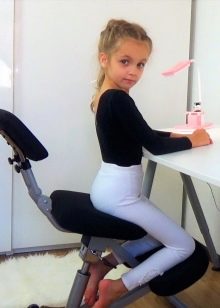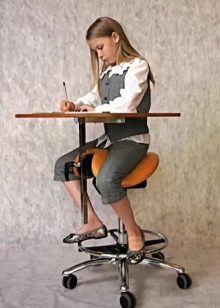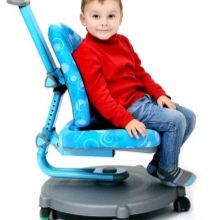Orthopedic chair for the student: tips on choosing

The rapid pace of life is quite severe: day after day, the spine is subjected to a huge load. This is especially true of schoolchildren: from an early age, children are forced to spend a lot of time in a sitting position, which is not the natural position of the spine. To help the child, parents purchase an orthopedic chair for the student. However, the choice is not so simple, because not every model is suitable for a particular child. We understand together.
What is it?
An orthopedic chair is a special piece of furniture that remotely resembles a computer chair, and in some cases a kind of stool. However, if the office option focuses on the design of the user's comfort, the orthopedic option does not intend to adapt to the student. You need to get used to this furniture yourself.Externally, the device can be different: simple, complex, supplemented by different functionality, however, it is special, its action is aimed at solving some diseases of the pupil's musculoskeletal system.
This means prevention and daily struggle with a curvature of a bearing. It is no secret that in modern schools there is no proper furniture: neither the tables nor the chairs in them are aimed at taking care of children's health. The desks are often not tilted, in the chairs, at best, you can raise the seat by setting the bolts to a higher position.
School chairs do not take into account the different age and complexion of children. This is a standard that damages the condition of the spine, day after day. Especially scary is the fact that the violation occurs for many years (the whole school period).
Functions
The benefit of an orthopedic chair for a pupil lies in the directional influence: it forces the child to sit straight, without skewing the back. Daily prevention often gives a positive trend: in addition to teaching the child to correct posture, you can gradually cure certain diseases. However, it is necessary to make a reservation - it is effective only in an integrated approach. In addition to the daily positioning in the correct posture, it is important to do special physical exercises.And it matters the correctness of the location on the chair: if you deliberately bend your back or retract your shoulders, there will be no sense from sitting.
The tasks of the chair are clearly defined, it is a necessary measure that provides the child with a benign mode of prevention and control of illnesses. Orthopedic chair contributes to:
- prevention of diseases of all parts of the spine;
- unloading of the spine, reducing pressure on the muscles and organs of the small pelvis;
- removal of numbness of the limbs;
- the formation of a beautiful and smooth posture;
- normalization of blood circulation and oxygen supply;
- ridding a child of persistent headache, aching pains in the back, shoulders, lower back;
- the formation of a beautiful and understandable handwriting.
Orthopedic chair is a durable product. He is not relegated to the corner, having learned to sit properly, he is needed every day to fix the orthopedic effect. Otherwise, there will be no sense from it.
Benefits
Children's orthopedic chair is a useful piece of furniture. Its effectiveness is proven by doctors. This product has a lot of advantages, it:
- maintains the proper muscle tone of the child’s body;
- in most models, it is distinguished by reliability and durability of the structure; it does not fall, does not drop the child, does not turn over if accidentally struck;
- It has accurate anatomical support for the back and seat, which is important for the user's comfort;
- differs in a rich model range, having a wide variation in size, fixing the child as accurately as possible in the right position or forcing him to take the only correct posture;
- regardless of the model, forms a flat line of the spinal column, excluding distortions in the direction or violation of posture;
- easy to use and convenient to adjust, adapts to the characteristics of the body of a particular child;
- depending on the model, it is equipped with different functionality, which is convenient for children of different ages and allows you to purchase the product for its intended purpose, avoiding unnecessary functions;
- it is carried out in strict compliance with safety requirements, therefore it is distinguished by a high-quality and reliable production assembly, having strong fastenings;
- almost always has a pleasant design, so it is liked by children of any age and can successfully fit into the interior composition of the children's room;
- Often made as an integral part of a set, adjusting to the height of a desk of a similar design, which allows you to organize a working area in accordance with a certain style;
- based on the price of components, the complexity of the design, the material of the assembly, is different in cost, which allows each customer to find an option to his liking, taking into account preferences and the planned budget.
disadvantages
The physical abilities of each child are individual. Even if the developer is confident that he has distributed the load correctly, not every model is suitable for selection: in some cases the weight has been moved to his knees. If at first it seems comfortable, after some time the situation changes, my legs go numb or start to hurt.
It is extremely important to consult with your doctor before buying: A specialist who knows the characteristics of a child’s illness knows how to redistribute the load on the spine.
If back problems lie in the wrong foot setting, pressure on the limbs can aggravate the problem.
In addition, the design features matter. The presence of armrests, declared as a useful element of the assembly, is a harmful factor. Often, when buying, sellers advise these models, however, it is thanks to the armrests and the hands lowered on them that the shoulders are raised, the correct position of the back is disturbed.Daily such a position violates the posture and provokes a curvature of the back.
Other disadvantages include price of models. It is no secret that the better the product, the more correct the shape of the back and the seat, the more expensive it is. Not every buyer can buy a model for 30000-40000 rubles. Of course, there are budget options, however, the effect of them is inferior to expensive counterparts. As a rule, in cheap models the back and the seat are straighter, the pillow filler is less elastic and durable, therefore it forms holes over time.
Kinds
Thanks to the development of modern technologies, developers have plenty of opportunities to improve the efficiency of models, to increase their quality and performance. Chairs are developed taking into account medical indicators, listening to the opinions of orthopedic surgeons. Conventionally, the range can be divided into three categories:
- chairs for primary school students (6-9 years);
- models for high school (9-12 years);
- designs for teens (12-15 years and older).
Each category is distinguished by its size, is set to approximate height and weight, is equipped with a system for adjusting components for the characteristics of complexion and may have different supports for the legs.However, not every product is worthy of purchase: often under the guise of orthopedic products, chairs of a creative look are produced without the desired effect. To buy a really useful chair, we denote the species.
This will help to understand how the model, the principle of their work, strengths and weaknesses. The existing range can be divided into two groups: classic and ergonomic models. All of them are designed for daily operation at the desk.
To ensure the desired effect, the designs are supplemented with pillows with orthopedic gaskets. The first few are close to office type devices, the second ones are more ergonomic, they are complex fixing devices or creative options without backs.
Constructions
Orthopedic models of chairs for children are diverse. Conventionally, they can be divided into three categories:
- without back;
- with back;
- with double back.
The line of classic options includes models of growing chairs, similar to a stepladder, the useful effect of which is minimal. Other models include height-adjustable devices, whereby you can change the height of the chairs, adjusting them to the age of the children and the height of the desk. This includes chairs with mobile rotating supports or without wheels.In the line you can find small chairs for children, tuned to comfort with back support.
Modern models differ ergonomic shape. They force the child to sit properly. These include:
- knee - a chair-chair with a back or without it, when sitting in which the load from the back is redistributed to the knees (the child rests with his knees on special pillows, while the feet are moved back);
- the saddle is an analogue of a classic chair with a slight difference: the seat cushion is made in the shape of a triangular saddle (as on a bicycle: raised in front, lowered on the sides);
- balancing - a rocking chair or a swinging construction that looks like a swing, with a seat on one side, and on the other, two knee pillows (a model without a back, forcing the child to constantly balance, forcing him to sit evenly, training the vestibular apparatus).
With external differences, the models may have in common: be equipped with one or two footrests, have a height adjustment of the seat and back, a back angle correction. Sometimes manufacturers provide rollers under the back.Often, for mobility, the product is supplemented with powerful wheels, rotating in different directions, so that the child can independently and effortlessly move the chair.
An interesting model is the version with a forked back, which is two identical halves located on the sides of the body rod. The model is similar to the classic chair: it can have a single, double rod or another system in which the backrest and the seat are raised or lowered. The backs have a concave shape, look symmetrical with respect to the spine. They do not have excess volume, so they allow the child to sit on the chair as comfortably as possible.
The differences include the possibility of adjustment: some products adapt to the user, others provide a minimum of adjustment (for example, raising the seat to two positions without adjusting the height).
Some models can be purchased independently orthopedic seat cushion. This is especially true for wooden models and old chairs with a washed pillow.
Materials
The raw material from which orthopedic chairs are made for schoolchildren is divided into body and auxiliary.For the frame, which is the basis of the product, wood and metal (steel or aluminum) are used. The materials are durable, reliable and durable. Of these, the tree is the most massive, it does not have a hollow structure, it is used as supports, guides, supports and a rod. The metal is lighter, such a case is presented in the form of hollow tubes, it is stable and provides reliable fastening of functional elements.
In addition to the wooden and metal base, plastic is used in the production. This is a polymer-based raw material, a matte or glossy derivative of plastic. It is an auxiliary element that covers the armrests, adjustment levers, fulcrum points, footrest and the body of the chair stem. The material is durable, but not resistant to significant mechanical damage, so it can break away from the base upon impact.
As pillows orthopedic chairs use a dense and elastic filler and high-quality textiles with high breathable properties. Children's range includes the use of natural fabrics and hypoallergenic synthetics. Pillows have an original shape due to the packing of a monolithic plan with a porous structure and resistance to crushing. The filler is designed for long-term use, it does not squander, but requires strict consideration of the weight load.
Design
The design performance of orthopedic chairs is primarily tuned to the functional. Such furniture is not welcome frilly elements, carved legs or decorative techniques. All that is permissible - to demonstrate the status through the material of the frame and upholstery pillows, using if necessary color contrast. The design is divided into age groups:
- for a first grader, an elementary school student, models with bright textile upholstery in blue, red, green, orange, pink, and lilac colors are released (simple drawings are allowed);
- for a high school student, emphasis is placed on monochromatic shades that differ in gender (mainly in soft and saturated colors);
- for a teenager, the main criterion is status: the model demonstrates the style, solidity of the material (metal case, leather upholstery in brown or black).
Main criteria
Choosing an orphan chair with an orthopedic effect is not based solely on external indicators. The correct approach implies taking into account different criteria, including active physical exercises, because it is harmful to sit on non-stop furniture for a long time without a break.When buying an orthopedic chair for a student, it is important to pay attention to a number of factors. It is important that the model:
- had a back, because not every child can daily balance, sitting on a chair, developing a vestibular apparatus;
- was equipped with a system of regulation and mounting ergonomic headrest above the anatomical backrest in height and angle of inclination;
- had the ability to accurately correct the back for the parameters of a particular child, reducing the load on the spinal column;
- was optimally heavy, stable, but not excessively massive, if necessary, mobile (convenient to move to any corner of the room);
- had the function of adjusting the height of the base itself and the rigidity of the swing (did not slip when the child landed, but clearly fixed the back, regardless of the user's weight);
- had at least five points of support with their blocking during homework or other work processes;
- it was safe: sharp elements of the structure were excluded, the raw materials should be environmentally friendly, any strong odor indicating harmful dyes or toxic glue should be excluded;
- as a case, it had steel or aluminum (wooden models do not always have comfortable pillows);
- had the right type of pillow filler (latex is in priority, its orthopedic effect is proven by medicine);
- differed "correct" type of upholstery: you should pay attention to natural or artificial leather or textiles with a dense texture with an additional removable cover (so easier to care for the product);
- passed the process of "fitting" to the convenience: if the child can not sit at this chair, he will experience discomfort, there will be no sense from the chair - the student will find more comfortable furniture;
- envisaged an affordable and convenient system of adjustment for the child’s parameters;
- differed correctly curved type of seat (sloping and soft front), having a depth of 50 cm.
In the process of buying it is important to consider five rules of a successful choice:
- the structure must have a footboard (it is unacceptable that the legs hang down or rest against the floor)
- exact age matching (marking indicates this criterion);
- no loose elements, this indicates a clear marriage;
- the angle between the thigh and the lower leg when sitting is 90 degrees (it is not adjustable);
- Purchase is carried out taking into account the wishes of the child.
You can not rely on advertising, it is important to study the reviews about your favorite school model, looking at the store. So you can understand whether it is suitable for age and height (for a first grader, teenager) and medical indications (posture disorder, cerebral palsy, scoliosis, lordosis).
Popular models
Despite the wide choice, buyers have their favorites products. These include:
- height-adjustable classic chair with a round footboard;
- anatomical version with adjustable backrest height and angle, double stand and wheel lock;
- ergonomic knee chair with backrest and soft knee stand;
- a double back version, with a steel rod and height adjustment of the backs;
- model-transformer with an inclination and an emphasis on knees, two double supports, absence of a frame core;
- folding wooden model with T-shaped legs without a back;
- a design without armrests on six points of a support with an ergonomic form of sitting, two backs and an annular footboard from plastic;
- model of steel with a support for the neck, anatomical solid back, annular footboard, sitting at an angle.
Reviews
Orthopedic chairs for schoolchildren are an effective tool for combating curvature of the back and other diseases of the musculoskeletal system. This is evidenced by the numerous reviews of parents who bought their children this furniture.
The results are based on medical indicators: the chairs really help relieve muscle tension, relieve the spine and relieve pressure on the pelvic organs.
Parents note that in some cases it is possible to fully restore the health of children: X-rays show a positive trend. Children get used to sit on orthopedic furniture, it seems convenient and comfortable. Sometimes the spine acquires the right flat line. However, the effect, according to parents, is largely based on an integrated approach: you need to follow the straight position of the back while sitting, periodically relax and regularly perform special physical exercises.
Review the orthopedic knee chair for the student see in the next video.



















































































